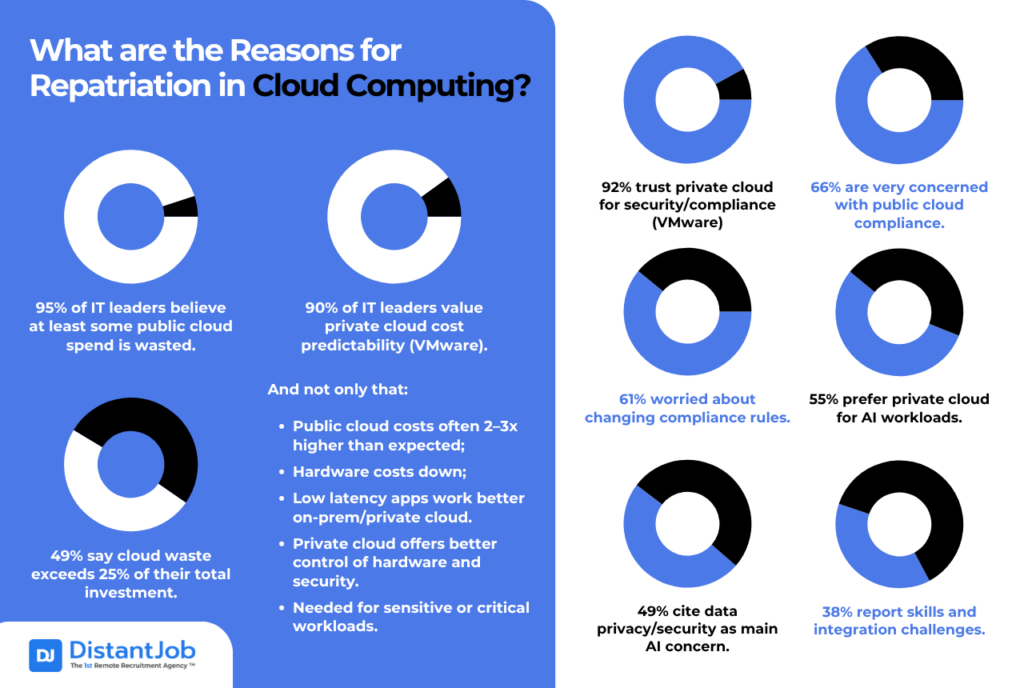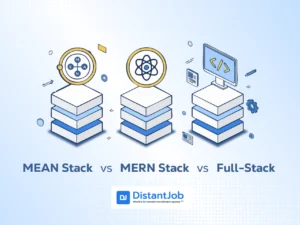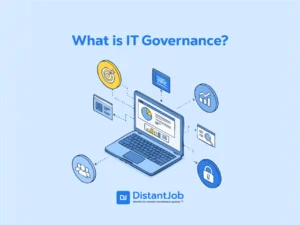For years, public cloud services have promised agility and scalability, leading companies to migrate their operations to these platforms. However, they became overly expensive due to egress fees, unpredictable usage-based pricing, and over-provisioning of resources. Does this mean your company is now at the mercy of cloud providers? No. This marks a new beginning: to reclaim the sovereignty that is rightfully ours! It’s time for cloud repatriation.
Cloud repatriation is the ongoing movement of workloads, applications, or data from public cloud environments back to on-premises data centers, private clouds, or hybrid infrastructures. According to VMware, 94% of IT leaders believe that at least some of their public cloud expenses are a waste. Cloud expenses are around 17% for companies, and it’s expected to rise to 28% in 2025, according to Flexera.
Let’s review the reasons for cloud repatriation, its benefits, and the process for doing so.
What are the Reasons for Repatriation in Cloud Computing?
The key drivers and reasons for cloud repatriation in 2025 include cost optimization and predictability, security and compliance, generative AI requirements, performance and latency, and greater control and workload sustainability.
Cost Optimization and Predictability
Many companies are finding that their public cloud costs are two to three times higher than initially anticipated, according to David Linthicum. As stated earlier, many IT leaders (nearly 95%) believe that at least some of their public cloud spend is wasted. Nearly half (49%) believe this waste exceeds 25% of their entire cloud investment.
Private cloud offers better financial visibility and predictability, with 90% of IT leaders valuing its cost predictability (VMware). In addition, hardware costs (servers, private clouds, on-prem data centers) have decreased significantly over the last decade. Owning hardware is much cheaper than it was 10 years ago.
Since we are living in an eroding economy, this is more than enough to advocate for mass public cloud migration. For example, 37signals expects to cut annual storage costs from $1.5 million to $200,000 by moving off Amazon S3, and Akamai recently saved $100 million/year by moving most of its infrastructure out of the cloud.
Security and Compliance
The VMware survey also found that 92% of the IT leaders trust private cloud for security and compliance. Private and on-premises environments offer greater control over data and systems. Concerns about maintaining compliance for data stored in public clouds are high, with 66% of respondents “very” or “extremely” concerned about public cloud compliance, and 61% concerned about keeping up with changing compliance requirements.
Industries like healthcare, finance, and government require strict adherence to regulatory standards (HIPAA, PCI DSS, GDPR, etc.); cloud repatriation helps them address this, allowing your company to regain control over sensitive data.
Data is the “crown jewel” of the company; sensitive information shouldn’t be stored on another company’s cloud.
Generative AI Requirements
GenAI is another major driving force behind the surge in cloud repatriation. It needs specialized computation (like GPUs), high-bandwidth networking, and massive storage. AI is very expensive: It consumes companies’ IT budgets. Training foundational models and running continuous inference pipelines challenges the economics of mass public cloud migrations. They require significantly more resources than a typical SaaS or data analytics workload.
According to the VMware survey, 55% of companies prefer private cloud environments for AI workloads for AI model training, tuning, and inference due to data sensitivity and latency needs. Data privacy and security concerns (49%) top the list of GenAI adoption challenges; other hurdles include skill shortages (38%) and integration with existing applications and data (38%).
Performance and Latency
According to Ussignal’s “Cloud Repatriation 101”, mission-critical applications requiring low latency may perform better on-premises or in private cloud environments. Cloud latency and network bottlenecks can impact application performance, especially for data-intensive applications. Cloud repatriation is a way to achieve better response times and improved processing power.
Greater Control and Workload Sustainability
Unlike the public cloud, on-premises and private cloud environments offer more control over hardware configurations, security policies, and network architecture, allowing your business to fine-tune its infrastructure for specific needs.
Not all workloads are optimized for the cloud. Some workloads perform better in a private cloud with dedicated infrastructure. For example, governments might prefer data-intensive, mission-critical, and cloud-native applications to gain greater control over costs, infrastructure, and resources.

Cloud Reset: A Shift in Cloud Strategy
The “Cloud Reset” is an emerging trend where companies move away from the previous rush to public cloud. Instead, they are now matching each workload with the cloud environment that best meets its specific requirements. The private cloud is now at the center of their strategy, alongside the public cloud.
Private Cloud as a Strategic Equal
Private cloud has achieved strategic parity with public cloud. According to the VMware survey, over half (55%) of government IT leaders prefer to build new workloads in the private cloud over the next three years. They surveyed 1,800 senior IT leaders and found that 53% plan to utilize private cloud to deploy new workloads over the next three years.
Workload Repatriation as Part of the “Cloud Reset”
Workloads, applications, and data are moving back to private clouds, on-premises environments, or hybrid infrastructures. It’s not a temporary measure or a strike against the public cloud services: It’s a growing trend.
According to the VMware survey, 69% of companies are considering or actively repatriating workloads from public to private cloud environments, with one-third having already completed this transition. Among government IT leaders, more than 70% are considering repatriation, and nearly 50% have already started.
Flexera’s State of Private Cloud shows a more conservative number for cloud repatriation (21% of workloads and data have been repatriated. However, ongoing migration to the cloud and net-new cloud workloads still outstrip these exits, resulting in continued overall cloud growth anyway.
The New Norm: Hybrid and Multi-Cloud Strategies
Cloud repatriation doesn’t abandon public cloud completely; instead, it evolves towards a more pragmatic, hybrid model. 93% of companies mix public and private clouds for optimal performance, cost, and control, according to the VMware survey. Hybrid Cloud is now the norm, with only a small percentage preferring an all-public or all-private cloud model.
Challenges in Cloud Repatriation
Despite benefits such as cost efficiency, enhanced performance, improved data security and compliance, and greater customization and control, cloud repatriation also presents several challenges that companies must navigate carefully.
While private cloud offers numerous advantages, challenges such as siloed IT teams or a lack of in-house skills/expertise can hinder its adoption.
However, addressing these challenges presents opportunities to accelerate private cloud momentum and further unlock its potential.
Migration Complexity
Repatriating workloads involves intricate processes such as moving data, reconfiguring applications, and maybe even re-architecting the existing infrastructure. Ensuring minimal downtime while maintaining data integrity during this transition requires meticulous planning and execution.
Upfront Infrastructure Costs
Unlike the public cloud’s pay-as-you-go model, moving workloads back on-premises or to private clouds demands an initial capital investment in hardware, networking, and storage. However, the long-term cost benefits will outweigh these initial expenses, especially given that hardware costs have significantly decreased over the last decade.
Talent and Skill Gaps
Managing on-premises or private cloud infrastructure requires a specific set of skilled IT professionals. A lack of in-house talent is a barrier to private cloud adoption by 30% of respondents on the VMware survey.
Years of public cloud investment haven’t closed this talent gap; 52% of companies still need professional services for cloud projects, according to the VMware survey. To succeed with cloud repatriation, you’ll need to either upskill your current team or hire cloud-skilled professionals.
Ongoing Maintenance and Management
Public cloud services provide automatic updates and maintenance. However, cloud-repatriated workloads require regular monitoring, patching, and management by the organization itself to ensure security and efficiency.
Siloed IT Teams
Siloed IT teams are identified as the number one challenge for private cloud adoption by 33% of companies in the VMware survey. Such silos create additional barriers affecting people, processes, and technology. They lead to operational complexity, a lack of consistent policy application, and, finally, resistance to cloud-based IT models. To overcome this, 81% of companies are restructuring their technical organizations around a platform team rather than traditional technology silos.
9 Best Practices for Repatriation
To successfully navigate cloud repatriation, you need to follow proven best practices. By implementing these strategies, you’ll maximize efficiency, security, and cost-effectiveness while leveraging the benefits of both public and private cloud environments
1. Assess Workload Suitability
Not every workload should be repatriated. Determine which workloads will benefit most from on-premises or hybrid environments. Smart workload placement matches each application to its technical, business, and financial requirements.
Workloads commonly considered for repatriation include those with high security or compliance concerns, data-intensive applications (often driven by generative AI), and mission-critical systems. Modern, cloud-native workloads are also increasingly being targeted for repatriation.
For example, both databases and database management systems would benefit from an on-premises environment or private cloud.
That being said, backup of the same databases and systems in a public cloud might become handy for efficient disaster recovery – just be aware of the expensive egress fees.
2. Calculate Total Cost of Ownership (TCO)
TCO aims to compare the long-term costs of public cloud versus cloud repatriation, factoring in hardware, licensing, staffing, and ongoing maintenance.
Public cloud services might become expensive due to egress fees, unpredictable usage-based pricing (due to auto-scalability features), and over-provisioning.
Private clouds offer better financial visibility and predictability. Cloud architects need to be as fluent in finance as they are in technical skills to optimize costs and reallocate budgets, particularly for demanding AI initiatives.
3. Develop a Phased Migration Plan
To minimize disruption and allow for adjustments, repatriation should be approached gradually, ideally starting with non-critical workloads. Then, proceed to create a backup of critical workloads on-premises and update it until cutting off the umbilical cord.
4. Optimize Security & Compliance Measures
Security remains a top cloud challenge. Before repatriation, companies must ensure that robust security policies, access controls, and compliance frameworks are in place to avoid vulnerabilities. Security and compliance concerns are a major factor in repatriation, especially due to sensitive generative AI data. Private clouds are overwhelmingly trusted more than public clouds for security and compliance.
5. Consider Hybrid & Multi-Cloud Options
Repatriation does not mean abandoning the cloud entirely; instead, it is about adopting a hybrid and multi-cloud strategy that balances workloads between on-premises environments and public cloud resources for optimal efficiency and flexibility.
Place the right workload in the right environment based on factors like cost, security, governance, and performance. The intentional mix of private and public clouds is the norm for 92% of enterprises (VMware).
6. Address Talent and Skill Gaps
You must train existing staff or hire new cloud engineers to repatriate workloads and manage the balance between public and private clouds. Over half of companies (52%) still rely on professional services for cloud-related needs, and 28% are heavily dependent on professional services for all aspects of cloud adoption, migration, and operation (VMware).
The point of cloud repatriation is regaining control of your applications, data, and services, using as few public cloud services as possible. The repatriation mindset should be employed for hiring staff for cloud management as well.
7. Overcome Siloed IT Teams
We already talked previously about siloed IT teams as the number one challenge for private cloud adoption by a third of companies (VMware). Silos create barriers that affect people, processes, and technology. To overcome this hurdle, 81% of companies are restructuring their technical organizations around a platform team rather than traditional technology silos, which helps streamline operations and ensure consistent policy application.
A platform (DevOps) team provides a cohesive strategy and a common set of tools and processes for repatriation, ensuring everyone is working towards a shared, well-defined target environment.
8. Implement FinOps and Centralized Cloud Governance
Managing cloud spend is a top challenge for 84% companies, according to Flexera. Companies are increasingly expanding FinOps teams (now 59% of respondents) and establishing Cloud Centers of Excellence (CCOEs) or central cloud teams (69% of respondents).
These teams advise on, manage, and execute cloud cost optimization strategies, gaining financial visibility and combating wasted cloud spend.
9. Plan for Ongoing Maintenance & Management
Unlike public cloud services that often provide automatic updates and maintenance, repatriated workloads require regular monitoring, patching, and management by the organization itself to ensure security and efficiency.
Public Cloud vs Cloud Repatriation Comparison Table
Here’s a table visualizing the benefits of public cloud versus private cloud/on-premises environments, based on what we discussed so far.
| Feature/Benefit | Public Cloud | Cloud Repatriation (Private Cloud / On-Premises) |
| Cost | It can become overly expensive due to egress fees, unpredictable usage-based pricing, and over-provisioning. High percentage of wasted spend (up to 95% for some IT leaders). | Better financial visibility and predictability (90% of IT leaders value this). Hardware costs have significantly decreased over the last decade, making ownership cheaper. |
| Security & Compliance | Concerns about maintaining compliance with data.66% “very” or “extremely” concerned about public cloud compliance. | Greater control over data and systems. 92% of IT leaders trust private cloud for security and compliance. Helps address strict regulatory standards (HIPAA, PCI DSS, GDPR). |
| Generative AI Workloads | Very expensive, challenging the economics of mass public cloud migrations.Requires specialized computation (GPUs), high-bandwidth networking, and massive storage. | 55% of companies prefer private cloud for AI workloads due to data sensitivity and latency needs. Greater control over specialized hardware. |
| Performance & Latency | Cloud latency and network bottlenecks can impact application performance, especially for data-intensive apps. | Mission-critical applications requiring low latency may perform better. Achieves better response times and improved processing power. |
| Control & Sustainability | Less control over hardware configurations, security policies, and network architecture. | More control over hardware configurations, security policies, and network architecture.Ability to fine-tune infrastructure for specific needs. Some workloads perform better with dedicated infrastructure. |
| Initial Investment | Reduces entry barriers and initial costs; pay-as-you-go model. | Requires initial capital investment in hardware, networking, and storage (though long-term benefits outweigh this). |
| Maintenance & Management | Public cloud services often provide automatic updates and maintenance. | Requires regular monitoring, patching, and management by the organization itself. |
Conclusion
The problem is not being “cloud-first”, but being “cloud-only”. When you pay for public cloud services, the bill might come out too high at the end of the month. If you have a start-up or a small or medium company, a public cloud will reduce entry barriers and initial costs. Understandably, businesses avoid upfront investments in hardware and IT staff. However, in the long run, you might benefit more from having your own on-premises infrastructure.
However, cloud repatriation is not about abandoning the cloud, but rather about a more mature and strategic approach to cloud adoption. Companies are realizing that a “cloud-first” strategy isn’t always a “cloud-only” strategy. The best environment for an application depends on its specific requirements regarding cost, performance, security, compliance, and control. A hybrid approach, combining the strengths of public, private, and on-premises environments, is often the most effective solution.
The future outlook for 2025 and beyond is one of strategic optimization, where businesses select the right cloud environment for their specific workloads.





